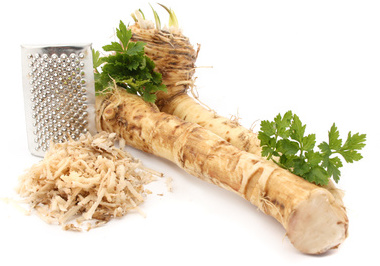
Health Benefits:
Aids in digestion
Anti viral qualities
Helps increase menstrual flow
Increases stamina
May reduce risk of cancer
Provides energy
Reduces risk of oral cancers
Relieves the symptoms of urinary tract infections
Nutrition:
Serving size: 1 tbsp; Calories: 7; Fat: .1g; Cholesterol: 0mg; Sodium: 63mg; Carbs: 1.7g; Fiber: .5g; Sugars: 1.2g; Protein: .1g; Potassium: 1%DV Vitamin A: 0%DV; Vitamin C: 6%DV; Calcium: 0%DV; Iron: 0%DV
Did You Know?
- Used topically, horseradish is known to soothe muscle pain and joint discomfort.
- Horseradish is a member of the mustard family.
- If you like horseradish as hot as it can be, use fresh horseradish roots. A good quality root is clean, firm, and free from cuts and deep blemishes.
- Contains cancer fighting compounds glucosinolates
Ways to Eat:
- Fresh grated
- In a creamy sauce
- On meat
Farming Trivia:
- In the United States, an estimated 24 million pounds of horseradish roots are ground and processed annually to produce approximately 6 million gallons of prepared horseradish
- Horseradish was widely used as a medicine during the Middle Ages. It was traditionally used for its heating, congestion clearing (especially sinus congestion), and antiseptic action; but also to help reduce fluid retention and to improve sluggish digestion
- Horseradish contains several nutrients including minerals, Vitamin C, and Sulfur. This makes it an excellent skin tonic and cleanser
Note: Always consult a physician for any specific health questions and concerns. Some of this information may be subject to change should there be any new findings from Federal Health Administration (FHA), Food & Drug Administration (FDA), American Medical Association (AMA), American Cancer Society (ACS), and / or other leading food, nutrition and medical advisors.

